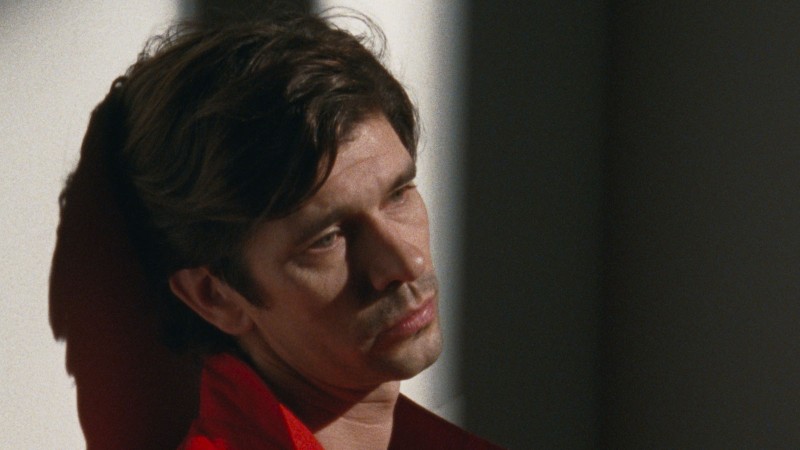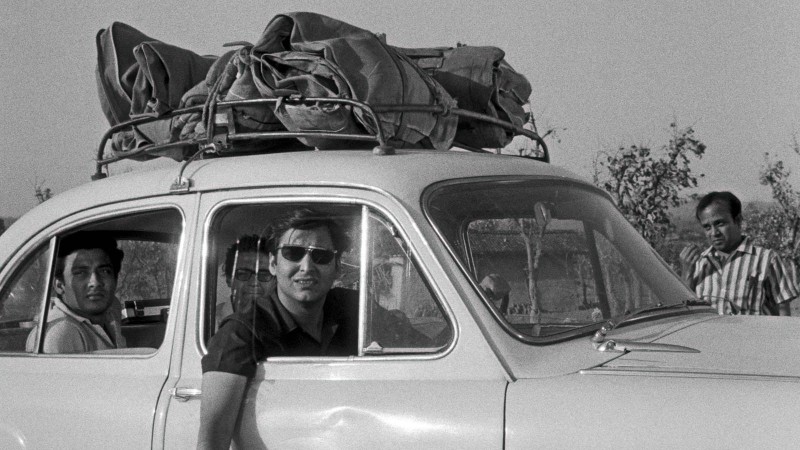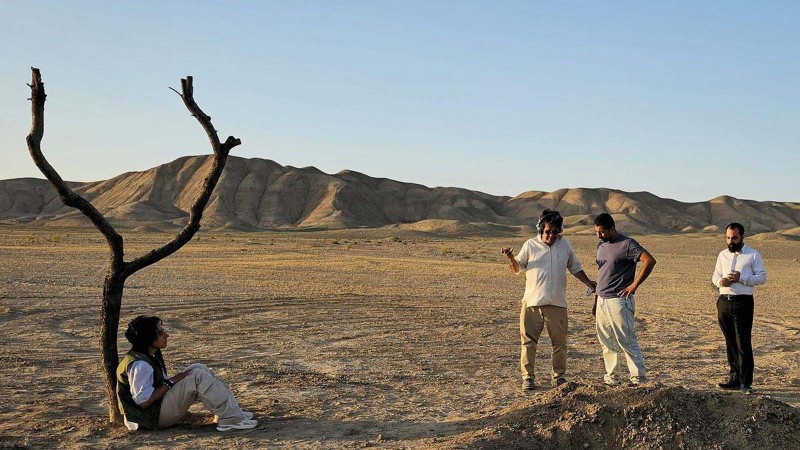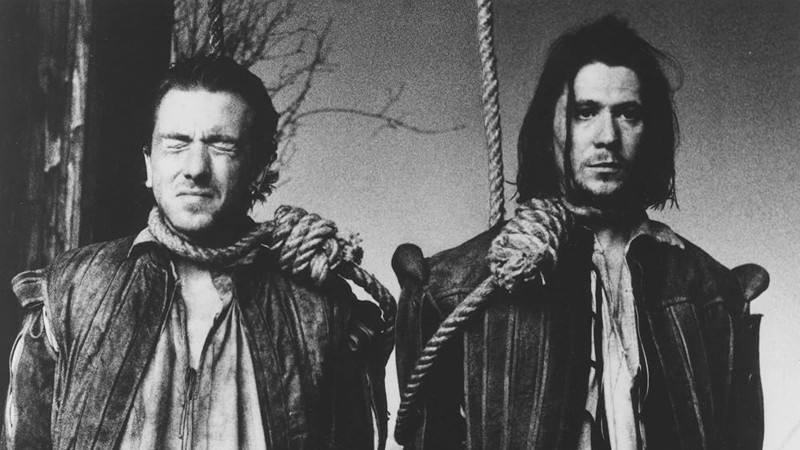Peter Fonda: Free to Ride

More than a few of the remembrances appearing since the death of Peter Fonda last Friday at the age of seventy-nine have pointed out that much of the actor, director, and screenwriter’s work after 1969 could be read as commentary on that year’s groundbreaking hit, Easy Rider. There were comically overt winks in the form of cameos as freewheeling bikers in a good number of movies in the decades that followed. And there were slightly more subtle nods such as the scene in Steven Soderbergh’s The Limey (1999) in which his Terry Valentine, a corrupt record producer, mansplains the ’60s to a girlfriend half his age. On-screen and off, Peter Fonda embodied a historical turning point as the producer, cowriter, and costar of the film that, more than any other, upended the Hollywood studio system that had made his father a star.
Henry Fonda had just broken into movies when he married Frances Ford Seymour in 1936. Their daughter Jane was born the following year, and Peter followed a little over two years later. When Jane was twelve and Peter was ten, their mother killed herself, and the details—a razor blade across the throat—were kept from the children for years. Though he was an outspoken champion of liberal causes, Henry was a cold and distant father, even before the death of Frances. “We would hear so much about how great our father was,” Peter told Bruce Weber in the New York Times in 1998, “and we were wanting a little of that in our house and not getting even a smell of it.” The rift between father and son only began to heal when Peter gave Henry a cameo in a comedic western he was directing, Wanda Nevada (1979). Jane more famously worked through her issues with Henry by casting him as her character’s cantankerous father in On Golden Pond (1981).
Peter Fonda studied acting in the mid-1950s, and by the early ’60s, he was appearing on Broadway and guest starring in television shows such as Naked City and The Alfred Hitchcock Hour. In his first film, Tammy and the Doctor (1963), he played Sandra Dee’s crisp young love interest. A year later, director Robert Rossen gave him something more substantial to work with, the role of a troubled patient in a mental institution in Lilith, which gave Fonda an opportunity to work alongside Jean Seberg and Warren Beatty. By the mid-1960s, though, Fonda was switching tracks, growing his hair out, dropping acid, and hanging with the Byrds, the Beatles—and Roger Corman.
Fresh off his cycle of films based on the work of Edgar Allan Poe, Corman sensed a shift in the zeitgeist and decided to make a movie about the Hells Angels. George Chakiris was supposed to play the leader of a rowdy and roving gang on wheels, but when Corman found out he couldn’t ride, he knocked Fonda up from a supporting role to the lead. Acts like Mudhoney and Primal Scream have periodically revived memories of The Wild Angels (1966) by sampling a speech Fonda delivers in response to a stern preacher’s question, “Just what is it that you want to do?” A slight pause, and then: “We wanna be free! We wanna be free to do what we wanna do. We wanna be free to ride. We wanna be free to ride our machines without being hassled by the man. And we wanna get loaded. And we wanna have a good time.”
The scene is an impromptu funeral the Angels have staged for one of their members, Loser. Speaking of Hollywood dynasties, Loser is played by Bruce Dern, and Diane Ladd is his girl. A year later, the couple, married at the time, had a daughter, Laura Dern. For all its impact on the culture, few would call The Wild Angels a great film. “A tawdry stew of brawling, shooting, rape, and macho self-pity, the movie was a huge hit in relation to its negligible cost, jump-starting audiences’ association of Fonda and Harley-Davidson motorcycles and spawning a subgenre of motorcycle pictures stretching into the 1970s,” writes Matt Zoller Seitz at RogerEbert.com.
Corman, Fonda, and Dern followed up on the tawdry stew with a movie written by Jack Nicholson and costarring Dennis Hopper. The Trip (1967) “was, and remains, one of the handful of Hollywood pictures to take the psychedelic experience seriously,” writes Glenn Kenny at the Decider. The Easy Rider team was just about set, but first, Fonda flew to Rome to costar with his sister Jane in a segment of Spirits of the Dead (1968), an omnibus film based on three stories by Poe. Federico Fellini and Louis Malle directed two of the adaptations, and the first was directed by Jane’s husband, Roger Vadim. Jane plays a countess who aims to seduce her cousin (Peter), and as Kenny puts it, “it’s a super-perverse but fascinating exercise. But the siblings get out with their dignity intact.”
Easy Rider (1969) was Fonda’s idea. Looking at a still from The Wild Angels, he dreamed up a western in which two wanderers, Wyatt (Fonda) and Billy (Hopper, also directing), named for Wyatt Earp and Billy the Kid, having smuggled cocaine from Mexico to Los Angeles, would take off with a wad of cash on bikes rather than horses, heading for New Orleans in time for Mardi Gras. Along the way, they’d pick up an alcoholic lawyer (Jack Nicholson, in the role that made him a star, a role that would have gone to Rip Torn if he hadn’t had a falling out with Hopper). After a bad acid trip with a two prostitutes (Toni Basil and Karen Black), first Billy, and then Wyatt are blown off the road by a couple of southern rednecks. “Fonda and Hopper fought over credit for breaking the mould,” writes the BFI’s David Parkinson, “but they would have produced something more Cormanesque without the contributions of screenwriter Terry Southern, cinematographer László Kovács, and editor Henry Jaglom.”
This year, on the occasion of the film’s fiftieth anniversary, Charles Bramesco wrote in the Guardian that Easy Rider “literally and symbolically marks the turning point at which the idealism of the ’60s curdled into the indulgent solipsism of the ’70s.” For Danny Leigh, also writing in the Guardian, the “power” of Easy Rider “wasn’t that it was a story of outlaw potheads, starring off-the-shelf hairy male leads. By 1969, anyone could have made that. It was the sense of a movie being of a generation, made without executive permission, that electrified a Vietnam-sick audience. It spooked the studios so badly they set loose untold cocksure young directors—Scorsese and Coppola et al.—in a desperate attempt to play catch-up.”
In the essay accompanying our release in 2010, Matt Zoller Seitz argues that Easy Rider “transcends its cultural moment, because it’s about more than bikers and hippies or the tension between libertines and reactionaries. It’s about the difficulty of escaping social conditioning and economic imperatives and sustaining a truly free life.” Writing about Fonda’s performance at RogerEbert.com, Seitz suggests that the “more you think about the different ways Fonda reinterpreted his Easy Rider character, the more he seems as integral to the actor’s filmography, and to America’s postwar self-image, as Clint Eastwood’s Man with No Name . . . As impossibly good-looking as his father and sister, Fonda played Wyatt with a touch of Eastwood’s whispery interiority, and a similar awareness of how to capitalize on patriotic imagery even while he critiqued it.”
In 1971, Fonda made his directorial debut with The Hired Hand (1971), starring himself and Warren Oates as a couple of drifters out for revenge. For Bilge Ebiri, writing for Vulture, the film—buried by its studio, Universal, but revived to great acclaim in 2001—is “one of the enduring masterpieces of 1970s American cinema.” Ebiri argues that The Hired Hand, which has been “described at various times as a feminist western, an acid western, a revisionist western, and not a western at all—none of these descriptions, by the way, is entirely wrong—represents one of the greatest examples of the genre. It blends an old-fashioned setup with a thoroughly modern approach, as if someone had thought to hijack John Ford’s 1946 classic My Darling Clementine (starring Henry Fonda, Peter’s father, and a film which the young actor-director made his crew watch before shooting The Hired Hand) and drag it kicking and screaming into the present day.”
Fonda directed only two more features, the low-key sci-fi drama Idaho Transfer (1973) and that western comedy, Wanda Nevada. He spent much of the 1970s appearing in drive-in fare such as Dirty Mary, Crazy Larry (1974) and Race With the Devil (1975), and outside of a cameo as the “chief biker” in The Cannonball Run (1981), not much of his work in the 1980s is all that memorable. In the 1990s, as his daughter, Bridget Fonda, was becoming a star, appearing in films by the likes of Barbet Schroeder and Quentin Tarantino, he started making better choices. At Vulture, director Michael Almereyda looks back on working with him on the vampire movie Nadja (1994). “He was at a low ebb in his career, I guess, and happy to be working, happy to trade in his cowboy boots, denim, and designer glasses for Van Helsing’s tweed,” writes Almereyda, who found Fonda to be “gallantly extroverted—a boundlessly democratic, uniquely American aristocrat.”
It was Almereyda who recommended Fonda to Victor Nuñez, who had written and would direct Ulee’s Gold (1997). For his performance as a widowed beekeeper charged with raising his two granddaughters alone, Fonda scored a Golden Globe and an Oscar nomination. “I wasn’t playing my Dad, but I was playing that type of character,” he told Bruce Weber. “I’d lived with him. I knew I could go back and touch those things and find the moments and tell them perfectly.” Writing about this “tremendous showcase” for Fonda in 1997, Adrian Martin called him “an actor in the tradition of Gary Cooper and Clint Eastwood: the muscles of his face do not move much, but his whole bearing, his gait and posture, the way he holds himself back and watches or propels himself into reluctant action, speak volumes. It is an extremely poignant performance.”
Steven Soderbergh gave Fonda his next landmark role in The Limey. “If Easy Rider’s Wyatt was the counterculture’s eulogist, Terry Valentine, the shady music exec Fonda plays here, is its living post-mortem,” writes Glenn Kenny. Danny Leigh notes that Valentine was “a relic from the counterculture who never grew up and had made all manner of compromises because of it. Soderbergh included a shot of a billboard where Valentine advertised American Express; the original ad had starred Fonda—a wry and fearless note of self-deprecation. To change history is one thing—to be frank about what happens afterwards takes rare honesty.”
Over the two decades that followed The Limey, Fonda appeared yet again in a couple of biker movies (Ghost Rider and Wild Hogs, both from 2007) and took a substantial supporting role in James Mangold’s 3:10 to Yuma (2007). But for the most part, the movies from this period haven’t left much of a mark. In 2017, Jared Moshe cast Fonda in The Ballad of Lefty Brown as a senator from the newly formed state of Montana, a character that Moshe modeled on John Wayne. “I wanted him for the role of legendary frontier rancher Edward Johnson because he’s a talented and creative actor,” writes Moshe in a tribute at IndieWire. “But also because of the history he brought to the role—the connection to an older Hollywood that doesn’t really exist anymore.”
For news and items of interest throughout the day, every day, follow @CriterionDaily.



